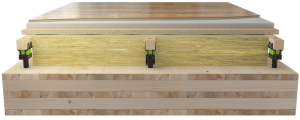Impact and airborne sound insulation in homes and offices

- Impact sound should be as low as possible.

- Airborne sound insulation should be as high as possible.
Effective insulation against sound from surrounding spaces is important for a good living and working environment. Investigations show that in older structures, residents are often disturbed by impact sounds, loud music, slamming doors and staircase traffic, as well as noise from running water, lifts, ventilation and traffic. A good sound environment has become a prioritised requirement when constructing new buildings.
Sound rating standards specify sound requirements for homes and premises.
The National Board of Housing, Building and Planning’s building regulations (BBR) set a generally formulated requirement that the sound environment of buildings must be designed so that residents and users are effectively protected from noise. In a general council, BBR sets a number of requirements for housing and premises. The Council also states that “if better sound conditions are desired, sound class A or B can be selected according to the SIS standards SS 25267 (housing) and SS 25268 (premises). Control methods are described in the National Board of Housing, Building and Planning’s handbook “Noise protection in homes and premises” (www.boverket.se) and in the standards. In practice, homes for sound class B are usually designed to meet customers’ wishes. The standards place special demands on sound insulation at low frequencies, as they have proven to be particularly important for the subjectively perceived sound environment. SP’s guide “Impact sound tested floor coverings”
(SP Rapport 2012: 47) shows how floor constructions can be chosen so that the impact sound requirements are met, and how you can calculate which sound class you get with a certain combination of wooden subfloor and floor construction. In buildings with the Granab system’s sound-absorbing subfloor system, you get a significantly improved sound insulation of the wooden subfloor (even at low frequencies) compared to conventional thin floor coverings.
Installations that are pulled freely under the Granab system do not give rise to frame noise because they are not pinned to the frame.
Documentation of Granab systems’ sound-insulating properties
Granab systems have been developed in close collaboration with researchers and acoustic consultants in the building industry to satisfy highly placed demands on impact and airborne sound insulation in homes, offices and schools. Granab systems function as supplementary insulation for building frameworks both in new construction and remodelling projects. The impact and sound insulating function of the systems has been carefully documented by means of laboratory measurements and a large number of field measurements in completed buildings. In this way, values for sound reduction could be established, permitting sound insulation in buildings to be verified with calculations. Calculation of sound insulation in completed buildings shall be conducted according to the Swedish and European standard SS-EN 12354, Parts 1 and 2 with input data from Granab. Input data for concrete subfloors is in the BASTIAN database, as well as at www.bastian.nu For timber or steel joist floors, contact Granab.
Read more about acoustics
Impact and airborne sound insulation
Impact and airborne sound insulation in homes and offices
Impact sound reduction in the lab
Impact and airborne sound reduction System 3000N
Impact and airborne sound reduction System 7000N
Step and airborne noise reduction CLT
Offices and public buildings
Catalogs
Movies
Our systems

Granab subfloor system 3000N
For adjustable heights from 30 to 140 mm, excluding floor covering.

Granab subfloor system 7000N
For adjustable heights from 50 to 420 mm, excluding floor covering.

Granab Subfloor system 8000W

Granab subfloor system 9000N
For adjustable heights from 70 to 420 mm, excluding floor covering.
